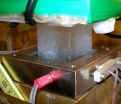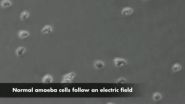The wild chimps inhabit Gombe Stream National Park, a 13.5 square mile preserve where they have been continuously observed from afar since famed primatologist Jane Goodall, Ph.D., began monitoring them more than 50 years ago.
A gene variant is a naturally occurring difference in the DNA sequence of a gene. Part of the chimp variant the scientists identified strongly resembles that of an analogous human variant known to slow the human immunodeficiency virus' progression to AIDS.
The gene in question is subject to evolutionary pressures that normally cause it to change rapidly over evolutionary time, resulting in many variants with diverse sequences. So the striking similarity of a section of the chimp and a section of the human variant implies two things, said Peter Parham, Ph.D., professor of structural biology and of microbiology and immunology. First, hominids have been fighting off HIV-like viruses at least since the two related species diverged some five million years ago. Second, because that particular section of the gene variant hasn't changed much since then, it probably plays an important role in increased survival among those inheriting it.
'Only a part of the chimp gene variant's sequence looks a lot like the human one. That immediately tells us this is the important part of the gene,' said Parham, the senior author of a study describing the findings. Unlocking this sequence's significance could yield not only biological insights but also pharmaceutical or, someday, perhaps even gene-therapy applications that enhance HIV-infected people's ability to avoid disease progression to AIDS, he said.
One of Parham's research focuses is a set of three genes called the major histocompatibility complex. The MHC codes for proteins that help the immune system recognize foreign substances. These proteins sit on the surface of virtually every vertebrate cell, where they serve as display cases for peptides -- small pieces of proteins -- chopped out of proteins that once resided inside that cell. It's the fate of all of a cell's proteins to eventually be degraded into peptides, which get transported to the cell's surface and encased in MHC proteins. This enables roving immune cells called T cells to inspect tissues and detect any peptides carved from proteins that are of foreign origin, such as those of a virus that has infected a cell, or have been altered, as in a cancerous cell. T cells often quickly mount an attack on cells bearing foreign or altered proteins.
In humans, HLA-B, one of the three genes in the MHC complex, is the blueprint for a protein that is the appropriate display case for a short peptide 'tag' from Gag, an HIV protein that manifests early in the course of infection. Studies have shown that HIV-infected people who carry a particular variant of this gene, known as HLA-B*57:01, resist progression to AIDS. Scientists think this is because the cell-surface protein encoded by the B*57:01 variant, which is present in about one in 10 people, displays its captive Gag peptide in a way that especially catches T cells' attention. Although the virus can mutate so its Gag protein is invisible to T cells, it doesn't get much time to do that -- and even then, success comes at a cost, Parham said. The resulting virus can't replicate as efficiently, so the disease can't progress as quickly to the full-blown, symptomatic stage.
In the Gombe chimps, SIV is endemic. 'About one in four animals is infected,' Parham said. But the likelihood of infection isn't distributed equally among them. The roughly 125 chimps occupying Gombe's mountainous terrain during the study's course lived in three geographically distinct communities. While the northern and central groups had low SIV-infection rates, that virus has a strong grip on the southern community. In this community, the newly discovered gene variant became more frequent over the study period, suggesting it may have been naturally selected for its capacity to enhance chimps' survival to reproductive age and beyond. The Parham group's genetic analysis supports that suggestion.
The original thrust of the study, Parham said, was to compare the MHC diversity of wild versus captive chimp populations to see how real-world exposures to pathogens might affect relative frequencies of various versions of particular MHC genes.
Close human contact with the Gombe chimpanzees is prohibited, so obtaining genetic material from them wasn't easy. Lead author Emily Wroblewski, Ph.D., a postdoctoral scholar in Parham's lab, recruited her former Ph.D. adviser from the University of Minnesota, behavioral ecologist Anne Pusey, Ph.D., who had done her graduate work in Gombe in the 1970s under the direction of Goodall. Wroblewski, who herself had spent 1.5 years in the Gombe doing field work for her Ph.D. thesis, also brought in prominent SIV virologist Beatrice Hahn, M.D., now at the University of Pennsylvania. In 2000, Hahn developed methods for extracting DNA and RNA from chimp feces. Over the past 15 years, she has established a large collection of fecal samples, now housed in Philadelphia. Both Pusey, now at Duke University, and Hahn are co-authors of the study.
Because the animals have been so carefully watched for so long, albeit always at a distance, each sample can be matched to a particular individual whose habits, maternal lineage and present social affiliations are known.
Wroblewski traveled to the Hahn lab, at the time in Birmingham, Ala.; coordinated the shipment of almost 300 fecal samples -- at least two or three per chimp -- from freezers in Hahn's laboratory to Stanford; and returned to Parham's lab, where she set up shop in one corner and began extracting DNA from the samples. Her DNA analysis permitted assessments of the chimps' MHC genes' status, and RNA analysis done by the Hahn lab enabled taking counts of SIV, which, like its cousin HIV, is an RNA virus.
Chimps have an MHC gene, PATR-B, which is functionally analogous to our HLA-B gene. The analysis found 11 different variants of PATR-B in the Gombe chimps, a surprisingly large number for such a tiny population. 'Seven of these variants had never been seen in captive chimp populations,' Wroblewski said.
After analyzing the first few dozen samples, Wroblewski noticed that the southern community showed an increase in frequency over time of one hitherto unseen variant of PATR-B called B*06:03. Further analysis showed that a stretch of B*06:03 was nearly identical to a stretch on B*57:01, the human gene variant associated with slower AIDS progression. Notably, fecal samples from SIV-infected chimps with the B*06:03 version of PATR-B had lower SIV tallies than those from similarly infected chimps without that variant.
'I found this to be quite exciting,' said Wroblewski. 'Fecal counts of SIV are a good proxy of viral load in the blood, which we have no easy way of measuring in Gombe chimps because we can't draw blood from them.'
Parham said, 'When a traditional field in biology starts to use new technology, it opens up enormous potential.'
INFORMATION:
Other Stanford co-authors of the study are senior scientists Paul Norman, Ph.D., and Lisbeth Guethlein, Ph.D.
Please mention PLOS Biology as the source for this article and include the links below in your coverage to take readers to the online, open access articles.
All works published in PLOS Biology are open access, which means that everything is immediately and freely available. Use this URL in your coverage to provide readers access to the paper upon publication:
http://www.plosbiology.org/article/info:doi/10.1371/journal.pbio.1002144
Contact corresponding authors:
Dr. Emily Wroblewski
eewro1@stanford.edu
Stanford University School of Medicine
Dr. Peter Parham
peropa@stanford.edu
650-723-6224
Stanford University School of Medicine
Bruce Goldman
goldmanb@stanford.edu
650-725-2106
Becky Bach
retrout@stanford.edu
530-415-0507
Citation: Wroblewski EE, Norman PJ, Guethlein LA, Rudicell RS, Ramirez MA, Li Y, et al. (2015)
Signature patterns of mhc diversity in three gombe communities of wild chimpanzees reflect fitness in reproduction and immune defense against SIVcpz. PLoS Biol 13(5): e1002144. doi:10.1371/journal. pbio.1002144
Funding: The Gombe chimpanzee MHC genetic data generation and analysis was funded by the National Institutes of Health (R01 AI 24258 and R01 AI 31168) and EEW was funded by an NIH/NIAID,
Ruth L. Kirschstein National Research Service Award (NRSA) (F32 AI085959). Samples received from Yerkes National Primate Research Center were collected with funding from ORIP/OD P51 OD011132.
All other Gombe population data collection was primarily supported by the Jane Goodall Institute
(JGI) and with additional support from the National Science Foundation (LTREB-1052693) and the
National Institutes of Health (R01 AI 058715). Digitization and analysis of population, SIVcpz, and microsatellite genetic data were supported by grants from the National Science Foundation (DBS-
9021946, SBR-9319909, BCS-0452315, BCS-0648481, LTREB-1052693), the National Institutes of
Health (R01 AI 058715), the University of Minnesota, the Harris Steel Group, the Windibrow Foundation, the Jane Goodall Institute, the Carnegie Corporation and Duke University. The funders had no role in study design, data collection and analysis, decision to publish, or preparation of the manuscript.
Competing Interests: The authors have declared that no competing interests exist.

